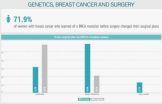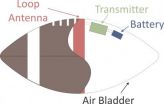(Press-News.org) PROVIDENCE, R.I. [Brown University] —Women diagnosed with breast cancer often face a crucial decision about the extent of their surgical treatment. Many meet national guidelines recommending testing for mutations in the BRCA 1 and 2 genes, which carry a substantial risk of future cancer. A new study reports that among women with breast cancer who undergo recommended testing before surgery, more than 7 in 10 who test positive will change their surgical plan, typically opting for a more extensive procedure such as a double mastectomy and sometimes ovary removal.
"As soon as somebody hears they have a 65 percent chance of a new breast cancer in the future or an up to 60 percent chance of ovarian cancer, they are likely to do whatever they can to prevent that," said lead author Dr. Elizabeth Lokich, an obstetrics and gynecology fellow in the Warren Alpert Medical School of Brown University and at Women & Infants Hospital.
The study appears online in the journal Gynecological Oncology with the recommendation that women who meet National Comprehensive Cancer Network guidelines for genetic testing get the test before deciding on their surgery.
"Particularly because of what we found – that it changes their surgical planning – it really makes the most sense to have this evaluation done pre-operatively," Lokich said.
The study was based on a retrospective review of the records of 302 Women & Infants breast cancer patients who had undergone preoperative genetic testing between 2006 and 2012 because they met the NCCN guidelines. Within that group, 32 learned that they carried a mutation in their BRCA1 or BRCA2 genes. With that information, 71.9 percent, or 23, of the women who tested positive changed their surgical plan compared to only 28.9 percent of women who tested negative.
Among the mutation carriers, 31.3 percent chose lumpectomies, while 59.4 percent chose double mastectomies and one in eight chose ovary removal. Among women who tested negative, 58.5 percent chose lumpectomies, only 20.7 percent chose double mastectomy and none elected to have their ovaries removed.
Stress and timing
Many women who meet the guidelines do not have a preoperative genetic test, even though it can provide important information. The effect of a positive BRCA mutation test on surgical decision-making had not been studied before and doctors have debated what the best timing should be. Some have argued that testing would add too much stress at a time when women are already coping with learning of their serious diagnosis. Indeed, Lokich acknowledged, some women choose not to be tested.
But Lokich said other studies suggest that genetic testing doesn't add much stress overall.
Instead, the likely reason most women in the study who tested positive for BRCA mutation often changed their surgery plan from lumpectomy to double mastectomy was to prevent a second bout of breast cancer or ovarian cancer.
In the study Lokich and her colleagues found that genetic testing significantly delayed getting to surgery, but not by enough to postpone it past the 90 days post-diagnosis that studies have shown to be clinically significant.
The authors therefore concluded, "We recommend that women meeting NCCN referral guidelines have their genetic evaluation done prior to surgical intervention."
INFORMATION:
In addition to Lokich, the paper's other authors are Drs. Ashley Stuckey, Christina Raker, and Jennifer Gass and genetic counselors Jennifer Wilbur and Jessica Laprise.
BRCA test results affect patients' breast cancer surgery plans
2014-06-13
ELSE PRESS RELEASES FROM THIS DATE:
Charity funding study brings alcohol industry influence on UK policy into question
2014-06-13
Five charities in the UK are both active in alcohol policy processes and funded by the alcohol industry, according to a new study published in the European Journal of Public Health.
The study, carried out by researchers at the London School of Hygiene & Tropical Medicine, looks at the relationships between the alcohol industry, charities and policy influence in the UK.
Two of the charities, Addaction and Mentor UK, are the only remaining non-industry, non-governmental members of the Public Health Responsibility Deal's alcohol network – the UK government's initiative ...
New membrane-synthesis pathways in bacteria discovered
2014-06-13
Biologists at the Ruhr-Universität Bochum (RUB) have discovered new mechanisms used by bacteria to manufacture lipids, i.e. fat molecules, for the cell membrane. Those mechanisms are a combination of familiar bacterial synthesis pathways and of such that occur in higher organisms. Thus, the team headed by Prof Dr Franz Narberhaus and Dr Roman Moser has debunked the long-standing theory that lipid production in bacteria differs substantially from that in higher organisms. The results have been published in the journal Molecular Microbiology.
Potential for the pharmaceutical ...
Are female hormones playing a key role in obesity epidemic?
2014-06-13
An imbalance of female sex hormones among men in Western nations may be contributing to high levels of male obesity, according to new research from the University of Adelaide.
In a paper published in the online journal PLOS ONE, researchers from the University's School of Medical Sciences suggest that obesity among Western men could be linked with exposure to substances containing the female sex hormone estrogen – substances that are more often found in affluent societies, such as soy products and plastics.
The research was conducted by University of Adelaide medical ...
Crossing the goal line: New tech tracks football in 3-D space
2014-06-13
Referees may soon have a new way of determining whether a football team has scored a touchdown or gotten a first down. Researchers from North Carolina State University and Carnegie Mellon University, in collaboration with Disney Research, have developed a system that can track a football in three-dimensional space using low-frequency magnetic fields.
The technology could be particularly useful for situations when the ball is blocked from view, such as goal-line rushing attempts when the ball carrier is often buried at the bottom of a pile of players. The technology could ...
Breakthrough for information technology using Heusler materials
2014-06-13
It is the breakthrough that physicists and chemists around the world have long anticipated and it will play a pivotal role in information technology in coming years. Researchers at Johannes Gutenberg University Mainz (JGU) have managed, for the first time, to directly observe the 100 percent spin polarization of a Heusler compound. Heusler alloys are composed of several metallic elements arranged in a lattice structure. They are among those materials that potentially can be used for ever smaller data storage components with ever greater storage capacity. However, doubts ...
Rescue of Alzheimer's memory deficit achieved by reducing 'excessive inhibition'
2014-06-13
A new drug target to fight Alzheimer's disease has been discovered by a research team led by Gong Chen, a Professor of Biology and the Verne M. Willaman Chair in Life Sciences at Penn State University. The discovery also has potential for development as a novel diagnostic tool for Alzheimer's disease, which is the most common form of dementia and one for which no cure has yet been found. A scientific paper describing the discovery will be published in Nature Communications on 13 June 2014.
Chen's research was motivated by the recent failure in clinical trials of once-promising ...
Genotyping can predict disease outcomes in rheumatoid arthritis patients
2014-06-13
New cohort studies presented today at the European League Against Rheumatism Annual Congress (EULAR 2014) have shown the amino acid valine at position 11 of HLA-DRB1 gene to be the strongest independent genetic determinant of radiological damage in rheumatoid arthritis (RA).1 In addition, positions 71 and 74 were found to represent independent predictors, with the three positions together: 11, 71 and 74 strongly associated with disease outcomes.1
According to lead author Dr Sebastien Viatte of the Arthritis Research UK Centre for Genetics and Genomics, Manchester, United ...
Higher health care cost burden of musculoskeletal conditions compared to other diseases
2014-06-13
A new study presented today at the European League Against Rheumatism Annual Congress (EULAR 2014) highlights the increased health care costs associated with musculoskeletal conditions compared to other diseases. Health care costs were almost 50% higher for people with a musculoskeletal condition compared to any other singly occurring condition.1
This disparity remained high where two conditions co-existed, with health care costs still one third higher (36%) for those people with one of their two conditions musculoskeletal in nature, highlighting the significant impact ...
Sjögren's Syndrome significantly increases risk of heart attack
2014-06-13
A new study presented today at the European League Against Rheumatism Annual Congress (EULAR 2014) showed a significantly increased risk of heart attack in patients with Sjögren's syndrome (SjS), particularly in the first year following diagnosis. There was also a trend towards an increased risk for stroke.
SjS is an auto-immune inflammatory disease where the body's immune system attacks glands that secrete fluid, such as the tear and saliva glands.2 Inflammation within the glands reduces fluid production causing painful burning in the eyes, dry mouth, and sometimes dryness ...
Biomarkers predict long-term outcomes in juvenile idiopathic arthritis
2014-06-13
Data presented today at the European League Against Rheumatism Annual Congress (EULAR 2014) demonstrate the possibility of using biomarkers (developed from whole blood gene expression profiles) in children with juvenile idiopathic arthritis (JIA) to predict the status of their disease at 12 months. The long-term disease status at 12 months was accurately predicted only after treatment had been initiated, in newly diagnosed patients.1
JIA is the most common childhood* chronic rheumatic disease,2 affecting 16-150 children in every 100,000. As indicated by the name, the ...


